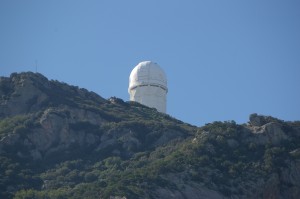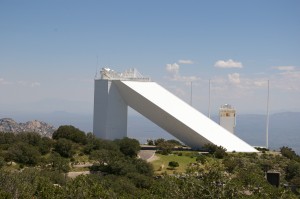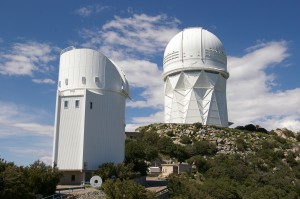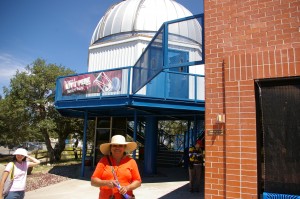TUCSON, ARIZONA – September 4, 2013. After visiting the Mount Lemmon SkyCenter two days earlier, it was now time for my wife and me to visit Kitt Peak during our time in Tucson. Kitt Peak is located about 60 miles southwest of Tucson, at an elevation of 6,875 feet in the Tohono O’Odham Nation. The National Observatory occupies this land by permit and under an agreement with the Tohono O’Odham tribe.
The drive to Kitt Peak is very scenic. Most of the drive out of Tucson is via Arizona State Highway 86, known as Ajo Way in Tucson. This highway travels over much flat desert, with Kitt Peak standing majestically before us as we approached the mountain. Before we reached Route 386 (Kitt Peak Highway), we encountered a U.S. Border Patrol station. Later we discovered that this is due to Route 86’s proximity to the US-Mexico border, rather than because of the border with the Tohono O’Odham Nation.
The Mayall 4-Meter Telescope Observatory from the road up to the summit. Photo by Bill Breeden.
Once we reached the base of the mountain, we drove the 12 miles up the mountain road to the summit of Kitt Peak. The many observatory buildings were quite impressive as we approached the visitor center.
We were scheduled for all four programs today, so this was sure to be fun (but long!) day. There were to be three telescope tours, then finally the Nightly Observing Program (NOP), starting at sunset.
Perhaps the most distinct building on top of the mountain, the McMath-Pierce Solar Telescope stands over 130 feet tall and extends more than 300 feet into the mountain itself. The building resembles the number “7” laying on its side, with the longest side facing due north, at an angle equal to Kitt Peak’s latitude of about 32 degrees. The solar telescope works by reflecting an image of the Sun down the long axis of the building, reflecting it back up the tube to yet another mirror, then back down again to be focused into equipment for analysis. All this length and reflecting cools the image to a manageable temperature. The Sun image is studied in many wavelengths, as well as spectroscopically. Currently, studies are being conducted on solar activity and why it is less than anticipated during this solar maximum.
The McMath-Pierce Solar Telescope. A mirror can be seen on top that follows the Sun across the sky and reflects its light down the telescope building. Photo by Bill Breeden.
At 11:30am, our tour or the 2.1 Meter Telescope began. Jim, our docent, explained that this telescope is a Cassegrain design built in 1964. It is still in use. The observatory building has a visitors area, basically a cordoned-off area surrounded by windows so that visitors can come in and see the equipment without disturbing the astronomers and observatory staff. If you have never seen a 2.1-meter (82 inch) telescope up close, it is very impressive. The telescope is equipped with imaging equipment attached where the eyepiece would be.
After the second tour, Rita and I enjoyed a leisurely lunch that we brought up the mountain in a cooler, along with lots of water and Gatorade. We had extra time available before the Mayall 4 Meter Telescope tour began at 1:30pm.
The Mayall 4 Meter Telescope Observatory is visible from Tucson, and is Kitt Peak’s flagship facility. This is also Kitt Peak’s longest telescope tour, lasting about two hours. Rita and I made the half-mile hike to the observatory (more difficult than we expected due to the altitude), and took many pictures of the observatory and the surrounding view from the mountaintop. Upon entering the building, we were guided to another “fishbowl,” a room specially designed to accommodate visitors. From this room, you can see the telescope, the gigantic mount, and the inside of the observatory dome. You can also see a control room, with working astronomers, telescope operators, and facilities staff.
The 4-Meter telescope and mount were truly of gargantuan proportions. This is a 158 inch telescope, to put it in familiar terms. The mount is not connected directly to the floor or to the catwalks that staff move about upon, but instead is fixed to a separate pier to isolate vibrations.
The 2.3-Meter Bok Reflector building (left), and the Mayall 4-Meter Building (right). The Mayall building is visible from Tucson. Photo by Bill Breeden.
Rita and I had planned our tours of Kitt Peak on the same day as the Nightly Observing Program, without having any real plans for the intervening two hours or so. The mountaintop closes to the public at 4:00pm, with only the visitor center opening again at 5:30 for the Nightly Observing Program. With nothing else to do, Kitt Peak staff played a DVD of Neil DeGrasse Tyson’s 400 Years of the Telescope, and we settled in the visitor center to watch the movie.
The Nightly Observing Program consisted of three parts: An overview of astronomy lecture, binocular observing, then telescope observing in the public telescope observatory next to the visitors center. The observatory contains a 20-inch Ritchey-Cretièn telescope, equipped with a 17mm Nagler eyepiece.
Two Kitt Peak docents, Lucas and David, shared the task of running the Nightly Observing Program for us tonight. Lucas began by providing all of us with a planisphere and showing us how to use it. Of course Rita and I already know how to use it, but the instructions were very helpful to the rest of the group. Next, he provided a nice pair of binoculars for each person for the evening, and showed us how to adjust and focus them for our eyes. Very informative, especially for those new to stargazing.
Then we were led outside to an area behind the visitor center to do some actual stargazing, both unaided-eye and binocular. Kitt Peak skies are very dark, showing as in the gray zone on Google Earth’s light pollution overlay. The Milky Way gleamed bright overhead, with the Great Rift obviously visible through Cygnus. Lucas pointed out various deep-sky objects for us to observe through our borrowed binoculars.
For the last part of the evening, Lucas turned over the program to David for running the telescope portion. Our group was led into the observatory next to the visitor center, under the illumination of glowing red light around the staircase leading into the building. The telescope viewing was run in a very organized fashion. We were seated along the inside wall of the observatory, and took turns approaching the eyepiece in the order we were seated. Only one person at a time was up at the telescope at any one time, so there was no bumping around the equipment (or other people) in the darkness. We were treated to views through the observatory 20-inch Ritchey-Cretien telescope. Objects were selected in approximate order of distance from Earth: First planets (Saturn), then stars (Albireo), nebulae (M17 and M8), an open cluster (M11), a globular cluster (M13), and finally the Andromeda Galaxy (M31). There may have other objects as well.
Rita Breeden (center) standing in front the of the public outreach observatory, next to the Kitt Peak Visitors Center. Photo by Bill Breeden.
The telescope observing lasted about 90 minutes. All of the objects were quite impressive through the eyepiece, although I will say that my enthusiasm for observing these objects through my modest 8-inch Schmidt-Cassegrain has not been spoiled. The thrill of observing these familiar objects through such a large telescope at an extremely dark location, great as it is, is about the same as the thrill of running my own telescope and spending longer amounts of time appreciating the beauty of each celestial target. The law of diminishing returns applies when observing through larger and larger telescopes. The views through very large telescopes are certainly better, but not as noticeable visually as you might expect. (Photographically would be another matter.) Kitt Peak is an amazing facility, and the contributions that have been made to science and astronomy are world-class. But for the visual amateur astronomer like myself, nothing still beats the thrill of setting up my own telescope, selecting my own deep-sky objects, and lingering at each one for as long as I like. After the airplane ride to Phoenix, the drive to Tucson and up Kitt Peak mountain, the drive to Danville does not seem the least bit daunting!
Ever drive down a mountain road, with hairpin turns, at night with your headlights off? I have now! Kitt Peak is a research observatory, so they require that you descend down the first mile or so from the summit with your headlights off. If your car has automatic headlights, they will tape covers over them until you reach the one-mile point. The idea of it was scarier than actually doing it. My eyes were dark adapted, and they lead you down that first mile by caravan. I simply followed the taillights in front of me, jokes about following taillights over the side notwithstanding. Anyway, Rita and I did just fine, and reached the base of the mountain, and finally back to Tucson, with no problem.
At the time of this writing, Kitt Peak telescope tours are priced at $9.75 per person for all three telescope tours (this is the total). You can also request a self-tour map and visit the same three telescopes on your own for no cost. The other observatories and telescopes on the mountain are not open to the public, but you are welcome to walk the grounds and take pictures. The Nightly Observing Program costs $42 person and includes a generous box dinner, which for us was a ham sandwich, potato chips, an apple, a granola bar, a small pack of Oreos, and bottled water. For more information about Kitt Peak’s tours and programs, visit their web site at http://www.noao.edu/outreach/kpoutreach.html.
Clear Skies,
Bill Breeden





